The Evolution and Art of Roller Skating
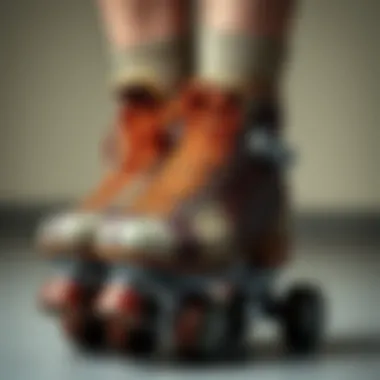
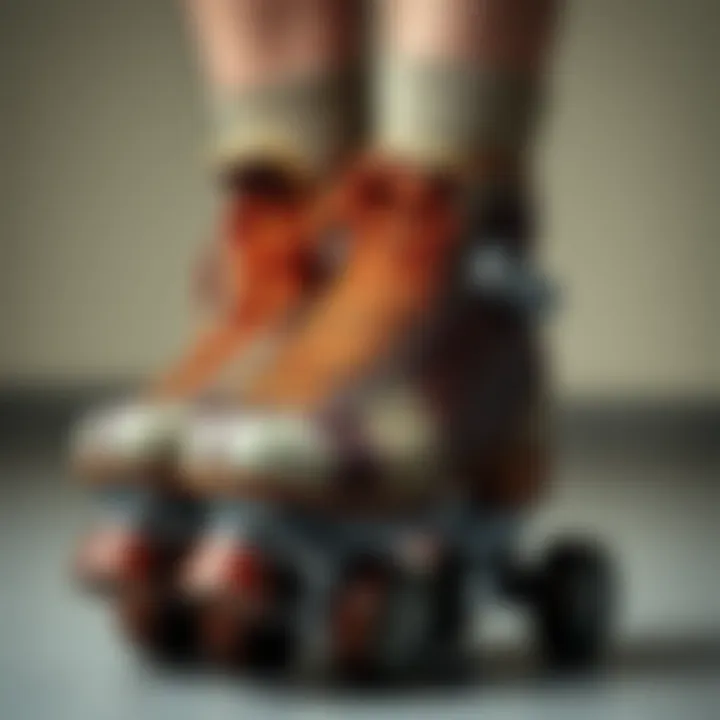
Intro
Roller skating has evolved from a quaint pastime into a dynamic blend of recreation and competitive sport. Its journey began in the 18th century, with the first patented roller skate in 1760, and has since morphed into various forms and styles that reflect changing interests and technological advancements. As we unpack the layers of this vibrant activity, we’ll examine its rich history, the techniques that define it, and the safety measures crucial for enthusiasts at all levels.
The Dance of Wheels
Imagine gliding across a smooth surface, wheels zipping beneath you, the rush of air mingling with rhythmic beats. The art of roller skating transcends the mere act of moving on wheels; it’s a cultural canvas painted with the influence of music, fashion, and community spirit. Whether on the smooth floors of a roller rink or the rugged paths of a skatepark, roller skating fosters not just a sport but an entire lifestyle. The world of roller skating is no longer confined to traditional circles; it's expanded into forms like jam skating, roller derby, and artistic skating, each with its own unique appeal.
Here, we will unfold the intricacies that contribute to the art of skating, beginning with some techniques and tips that are essential for mastery.
Historical Overview
The story of roller skating is anything but straightforward. Understanding its historical roots provides not just context but a rich tapestry woven with innovation, culture, and societal shifts. This section unpacks the journey, crucial for both enthusiasts and casual readers who dare to take a voyage through the ages of roller skating.
Origins of Roller Skating
Roller skating traces its origins back to the early 18th century, a creative leap rooted in necessity and imagination. The first recorded mention was in 1743, when a Belgian inventor, Joseph Merlin, demonstrated a pair of wooden skates in a London ballroom. Heavy wooden wheels and, at times, a touch of madness were on display, carving an initial path that would eventually inspire future generations to glide with grace.
Skating began gaining traction in Europe, partly due to the growth of newly constructed wooden rinks. These were not just simple spaces; they became social hubs where the elite would come to showcase their skill and style. But as with many innovations, roller skating hit rough patches—fading towards obscurity as times changed.
Rollerskating captured the thrill of movement, freedom and a sense of belonging in communal spaces.
Invention and Evolution of the Skate
As the years rolled on, so did the technology behind roller skates. The introduction of the first metal wheels in the late 1800s was a game-changer, but it was not until the 1930s that the design was truly refined. The ball bearings, a simple yet ingenious addition, allowed for smoother rides.
In the 1970s, the rise of the quad skate brought about a revival like no other. With a more stable design, quads helped people not just skate but dance and have fun. The term "roller disco" emerged, encapsulating an era where leisure and entertainment paved the way for a cultural phenomenon. Meanwhile, the inline skate, which rolled onto the scene in the 1980s, paved new avenues for speed and agility, drawing in daring fans looking for a faster thrill.
Cultural Impact Through the Decades
The cultural ramifications of roller skating have morphed significantly over time. In the 1970s and 80s, roller rinks became epicenters of social activity, especially for teenagers. Bands and DJs would create a vibrant atmosphere that turned skating into a rite of passage—the roller rink was where friendships blossomed and relationships formed, set to the sound of disco beats.
However, roller skating isn't just a fad; it became intertwined with art forms and lifestyle movements. Hip-hop and later, skate punk culture embraced skating, embodying rebellion and freedom. The 90s witnessed skateboarding influence on roller culture, introducing tricks and flips that added a flair for daredevils.
In many ways, roller skating has endured, adapting to shifts in music, fashion, and technology. From the raucous POVs of disco dance-offs to the polished precision of roller derby, the scene continues to evolve while carrying the echoes of its rich past.
Types of Roller Skating
Understanding the various styles of roller skating is essential in appreciating its diverse appeal. Each type offers unique experiences, suited for different interests and skill levels. Whether it’s the grace of artistic skating or the competitive edge of speed skating, each style has its own charm and challenges. The types of roller skating explored here can serve not only to expand one’s skating horizons but can also enhance enjoyment of the sport.
Artistic Roller Skating
Artistic roller skating combines dance and skating into a visually stunning performance. Skaters glide gracefully, showcasing their technical skill while expressing emotions through movements and choreography. This style is often performed on rinks and features disciplines such as solo dancing and pairs skating, much like its ice-skating counterpart.
Typically, artistic skaters undertake rigorous training focused on precision, rhythm, and artistry. They develop a style that highlights their individual characteristics, often bringing elements of drama or storytelling into their routines. Competitions for artistic skating are both challenging and rewarding, with participants judged on technical skill, interpretation, and presentation.
Benefits include:
- Improved balance and coordination
- Increased strength and flexibility
- Opportunities for artistic expression
Artistic skating is not just about competition; it builds community, fostering relationships among skaters who share a passion for creativity.
Speed Skating
Speed skating is for those who thrive on adrenaline. Here, the focus is on going fast, either on roller skates or inline skates. The essence of this type lies in the smooth, aerodynamic form skaters adopt, maximizing speed and efficiency. Speed skating can be done in various formats, from short track to long-distance racing.
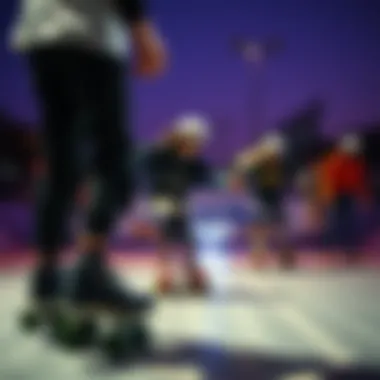
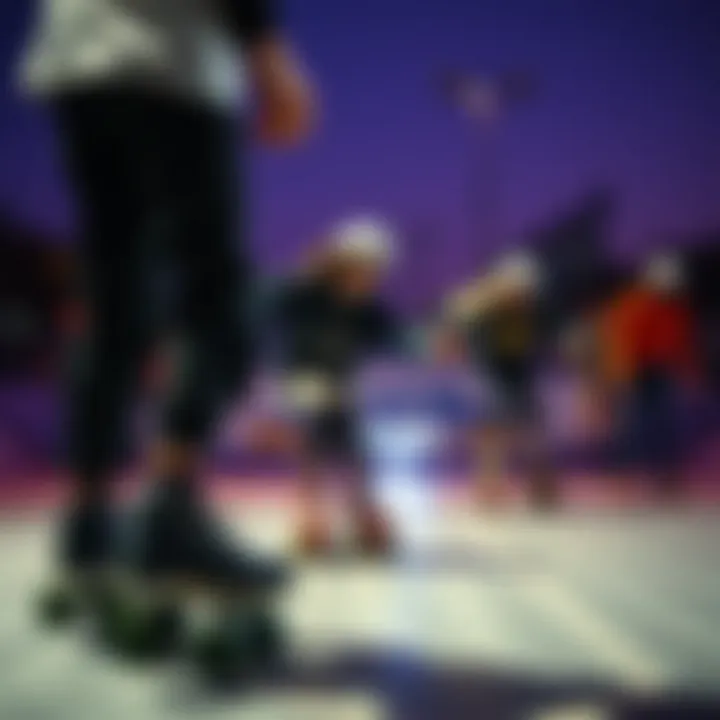
Typically, competitors train for stamina, strength, and technique, aiming to shave off every millisecond possible. Races are often exhilarating spectacles, drawing in spectators who can feel the energy of athletes competing at high speed. Furthermore, it has a strong community aspect, with clubs and teams that train and compete together.
Considerations include:
- Proper equipment, like well-fitted skates to enhance performance
- Physical conditioning to reduce injury risk
Speed skating isn’t just a sport; it’s a thrilling lifestyle for those who love the sensation of pushing their limits.
Roller Derby
Roller Derby comes with a reputation that's as tough as the skaters themselves. Originating from the mid-20th century, this exciting contact sport is a blend of athleticism, strategy, and teamwork. Teams race around an oval track, scoring points by passing opposing team members, all while tackling opponents and defending their own players in a whirlwind of action.
The camaraderie and fierce competition create an electric atmosphere around events. Roller Derby is uniquely crafted for provides skaters of various shapes and sizes a platform to excel, making it deeply inclusive. Players often adopt unique personas, contributing to the vibrant culture that surrounds this sport.
Key elements include:
- Physical resilience: skaters endure bumps and falls while navigating chaotic play
- Team coordination: successful plays rely on exceptional teamwork and communication
Roller Derby has gained popularity not only for its intense competition but also for its empowering community that challenges traditional norms associated with women's sports.
Freestyle Skating
Freestyle skating is where creativity takes center stage. This form includes various styles such as slalom, jam skating, and trick skating. Much like a painter with their brush, freestyle skaters express their individuality through a blend of skill, rhythm, and personal flair.
Freestyle skaters often perform tricks, spins, and jumps, showcasing their unique styles. While there’s a competitive aspect, freestyle skating deeply emphasizes self-expression and practicing creativity – a true exhibition of how skating can be both an art and a sport.
Freestyle skating offers several benefits:
- Enhanced technical skills
- Opportunities for self-expression
- A welcoming community of creativity and innovation
Technical Aspects
When it comes to roller skating, understanding the technical aspects is as crucial as honing the skill itself. The right gear, techniques, and maintenance contribute substantially to both the enjoyment and safety of the activity. Without a solid grasp on these components, even the most enthusiastic skater might find themselves struggling or, worse, risking injury. Knowing how to properly care for your skates and utilize various techniques can significantly enhance your experience on the rink or the path.
Essential Gear and Equipment
Skates
Skates are, undoubtedly, the primary equipment for any roller skater. Various types exist, like quad skates and inline skates, each serving a different purpose. Quad skates, for instance, are characterized by their two front and two back wheels, providing excellent balance for beginners. Inline skates, on the other hand, feature a single line of wheels, promoting speed and agility. One noteworthy feature of quad skates is their stability during side-to-side movements, which makes learning easier for newcomers. However, the streamlined and faster design of inline skates appeals more to those looking to gain speed and perform tricks. Thus, choosing the right type of skate is a stepping stone in determining your roller skating journey.
Protective Gear
Protective gear is not just an accessory; it’s a necessity! Wearing safety equipment like helmets, knee pads, elbow pads, and wrist guards greatly minimizes the risk of injury. These items absorb impact during falls, which are inevitable, especially for beginners. For example, helmets often come equipped with ventilation, protecting the head while ensuring comfort during extended use. It’s worth noting that while some may feel bulky in protective gear, the peace of mind it offers far outweighs any sense of inconvenience. Choosing to skate without proper protection is like wandering into a storm without an umbrella—foolhardy at best.
Maintenance Tips
Maintenance is the unsung hero of roller skating. A well-maintained set of skates not only prolongs their life but also enhances safety during use. Regularly checking wheel alignment, tightening bolts, and cleaning bearings can seamlessly elevate your skating experience. For instance, dirty wheels can lead to poor grip and control, which can lead to falls. A handy tip is to clean your wheels after every few uses, removing dirt and debris. This small step can significantly improve your skating smoothness while also ensuring your equipment remains in tip-top shape.
Skating Techniques
Basic Movements
Basic movements are the foundation of all skating skills. Being able to move forward, stop, and turn efficiently creates a solid base for more advanced techniques. Techniques like the "T-stop"—where you drag one skate perpendicularly to the other—are essential for slowing down safely. Moreover, gaining proficiency in these movements supports confidence in beginners as they explore the rink or outdoors. Standing tall with knees slightly bent ensures stability and facilitates smoother transitions to more complex maneuvers.
Advanced Skills
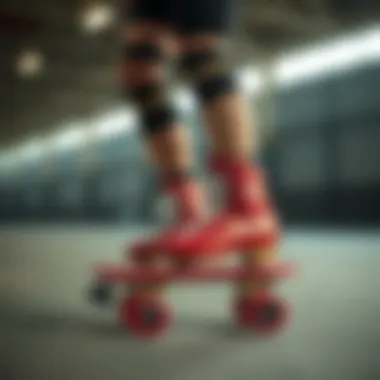
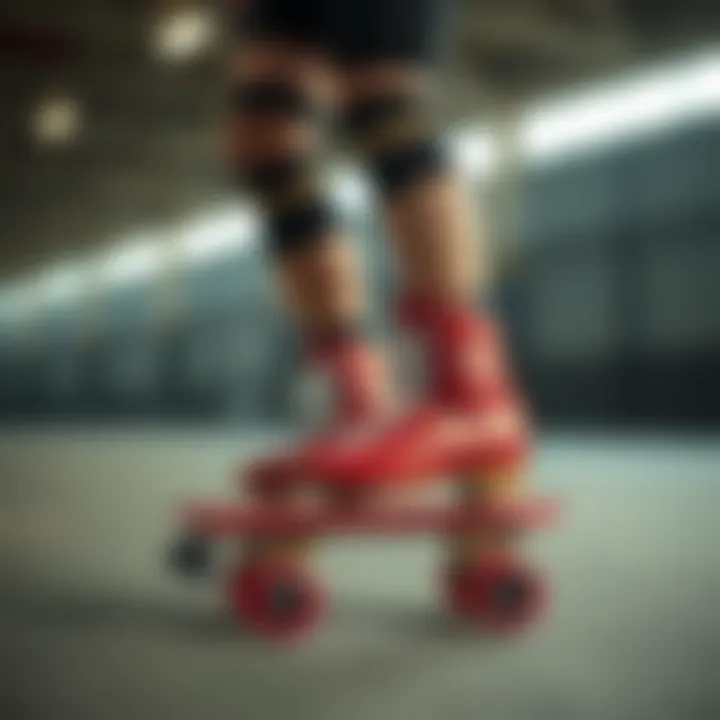
Once the basics are mastered, advanced skills open up a world of possibilities in roller skating. Techniques such as jumps and crossovers enhance performance and style, allowing skaters to express their individuality. For example, performing a crossover can be a vital skill for those participating in roller derby or artistic skating. Such moves often involve a deeper understanding of balance and weight distribution, which can take training and practice to perfect. However, mastering these skills often leads skaters to enjoy higher satisfaction levels during skating sessions.
Transitioning Between Styles
Transitioning between styles is an essential skill for versatile skaters. Whether switching from artistic skating to speed skating requires not only different gear but also an adapted approach to techniques. Mastery in transitioning enhances one’s overall skating skill set and opens the door to engage in various forms of skating. The critical aspect of this transition is understanding the nuances of each style, recognizing how each technique affects movement. Fine-tuning these transitions can be complex but ultimately enriches your skating repertoire, allowing you to seamlessly switch gears from one form to another.
Embracing the technical aspects of roller skating transforms it from mere recreation into a thrilling and skillful dance on wheels.
By comprehending the characteristics of your gear, understanding essential techniques, and emphasizing maintenance, you’re laying the groundwork for a fulfilling roller skating experience. Skaters who take these elements into account are not only safer but often find themselves developing a deeper passion for the craft.
Safety Considerations
Safety is a cornerstone of enjoying roller skating, especially as the sport evolves and attracts more enthusiasts. Understanding the proper precautions can mean the difference between a thrilling glide and an unfortunate spill. Roller skating is not just about mastering spins and tricks; it’s also about ensuring that every skater, whether novice or seasoned, remains safe while experiencing the joy of the ride. Safety isn’t just a good idea; it’s an absolute necessity.
Importance of Protective Gear
When you lace up those skates, protective gear isn't something to scuff at. Helmets, knee pads, elbow pads, and wrist guards create a buffer, safeguarding the skater from potential injuries. It’s astonishing how a little padding can drastically reduce the risk of serious damage during a fall. Think about it; a helmet can protect your noggin, while knee pads can save your joints from scraping on rough asphalt or wooden rinks.
- Helmets: A well-fitted helmet can absorb impact, saving your head from serious injury.
- Knee and Elbow Pads: These not only cushion impacts but can also help you maintain your confidence when skating. Knowing you’re covered can encourage the learning of new skills.
- Wrist Guards: Falling on outstretched hands is a common occurrence. Wrist guards help prevent fractures and strains that can occur from such falls.
Wearing protective gear is not just for beginners. Even experienced skaters can find themselves tumbling due to unexpected situations. Does it feel cumbersome at first? Sure. But getting used to wearing gear is much better than the alternative of skating without it.
Common Injuries and Prevention
Falling is an inevitable part of roller skating; it’s just a part of the learning curve. However, there are some common injuries that skaters tend to encounter.
- Fractures – Often to the wrist or collarbone.
- Sprains – Particularly in the ankle or wrist areas.
- Contusions – Bruises from falling on hard surfaces.
Understanding how to prevent these injuries can keep the good times rolling. Some preventive measures include:
- Regular Maintenance of Skates: Ensure that your skates are in good condition; check that wheel bearings are free of debris and wheel replacements are timely.
- Proper Warm-Up: Like any physical activity, warming up helps get your body ready. Simple stretches can enhance balance and flexibility, lowering injury risk.
- Choosing the Right Surface: Skating indoors on smooth surfaces can minimize the chance of falling compared to uneven outdoor surfaces.
“An ounce of prevention is worth a pound of cure,” so taking these preventive tips to heart can go a long way.
Environmental Factors to Consider
Skating conditions play a significant role in both the experience and safety of roller skating. Various environmental factors can impact skating, and understanding these can help skaters make informed choices.
- Surface Quality: Is it smooth or bumpy? Smooth surfaces, like wooden rinks or smooth concrete, are preferable, whereas gravel or uneven pavements present substantial risks.
- Weather Conditions: Moisture can make surfaces slick, increasing the chances of slips and falls. Always check if the surface is wet due to rain or dew.
- Crowded Spaces: Skating in busy areas can lead to collisions. It’s crucial to maintain space between you and other skaters.
Being mindful of these factors enhances safety. By taking a moment to assess your skating environment, you can better prepare for a safe and enjoyable session on wheels. Ultimately, when skaters prioritize safety, they’re setting the stage for a fun and fulfilling skating experience.
The Community and Culture
The world of roller skating isn't just about wheels gliding over pavement; it is about community, culture, and passion. This section delves into the fabric that binds skaters together, illustrating how they share experiences, passion, and a love for the sport. Understanding this aspect not only enriches the appreciation for roller skating but also showcases the social dynamics that come into play, making it a unique and engaging pastime.
Face of the Skating Community
Roller skating has attracted an eclectic bunch of enthusiasts over the years. From the hip city dwellers cruising urban sidewalks to the families enjoying a fun day at the roller rink, the diversity is wide and welcoming. Typically, one might see individuals from various walks of life united by a common love for the glide.
Women in particular have had a significant role in shaping the roller skating landscape, often leading initiatives within the community. They advocate for inclusivity and representation at skating events. The innovative spirit pushed them to create spaces, both virtual and physical, where skaters can express themselves freely without fear of judgment. Not merely a sport, roller skating serves as a social glue that fosters friendships, experiences, and sometimes even lifelong bonds, imbuing the culture with shared histories and a vibrant energy.
Events and Competitions
As any avid skater will tell you, exhibitions and competitions aren't just venues to showcase skills; they're social events that strengthen community ties. Across the globe, local skate parks, rinks, and festivals hold events that attract participants and spectators who share a passion for skating.


Some notable events attract skaters from all corners. The Roller Skating Association, for instance, organizes national competitions where both novice and seasoned skaters compete for titles, prizes, and recognition. Another buzzing event is the Roller Disco Nights held in bustling cities, where everyone puts on their best moves under dazzling lights. The atmosphere alive with laughter, music, and the unmistakable sound of wheels against the floor.
Importantly, these gatherings support the sense of community. Participants often cheer for one another, forming camaraderie that can be seen in cheering squads and personalized banners for their favorite skaters. The communal spirit during such events is akin to the rousing energy found in live sports—where attendees are united by a shared thrill.
Social Media Influence
In today's digital age, social media has emerged as a game changer for the roller skating community. Platforms such as Instagram, TikTok, and Facebook are teeming with content from skaters showcasing their routines, tricks, and adventures. Not merely places to strut skills, these platforms act as virtual gathering spots for enthusiasts.
With so many hashtags like #RollerSkating, #SkateCommunity, or #RollerSkateLife, skaters can easily connect, thereby expanding their social circles and sharing tips, challenges, and support. The visual nature of social media has propelled the rise of skate trends and fashions, making roller skating not only a sport but also a lifestyle ingrained with artistic expression.
Social media draws a global sketch of the skating community, illustrating diverse expressions of style, skill, and creativity that transcend geographical barriers.
The influence here is profound; a simple video can garner followers who replicate and remix moves, leading to viral dances that transform how roller skating is perceived. As a result, the community has thrived as new waves of enthusiasts are inspired to take up skating, connecting generations of skaters in the process. Decisions on equipment, styles, or techniques often spill over from online interactions, creating a fusion of old-school and contemporary skating culture.
All in all, the community and culture surrounding roller skating are central to understanding its evolution. They shed light on how this activity transcended the realm of simple recreation to become a lifestyle that is alive, thriving, and endlessly adaptable.
Emerging Trends
Emerging trends in roller skating reflect the adaptability and innovation within this dynamic sport. As skating continues to evolve, so do the techniques, gear, and overall culture surrounding it. Understanding these trends is essential not just for enthusiasts but also for those looking to stay ahead in the game.
Impact of Technology on Skating
The integration of technology into roller skating has revolutionized the way skaters experience their sport. From advanced materials used in skate design to apps that track performance, technology is now a cornerstone of modern skating culture.
- Smart Skates: Recent innovations have introduced smart skates equipped with sensors. These devices monitor speed, balance, and even energy expenditure, providing feedback that can help skaters refine their skills. Imagine adjusting your technique mid-skate based on real-time data!
- Virtual Reality Training: Training has taken a leap forward, with VR enabling skaters to practice complex routines in a risk-free environment. Whether it's simulating a competition setting or working on specific moves, VR brings an immersive quality to practice.
- Online Communities and Coaching: Online platforms have burgeoned, where skaters share tips, videos, and tutorials. This digital space fosters community and facilitates access to expertise from around the globe. For the skater looking to improve, these resources can be invaluable.
Sustainable Practices in Roller Skating
As roller skating grows in popularity, there’s an increasing recognition of the environmental impact associated with the sport. Sustainable practices are now being embraced by both manufacturers and skaters alike.
- Eco-Friendly Materials: Many brands are shifting towards sustainable materials in skate manufacturing. From biodegradable plastics to vegan leather, greener options are becoming commonplace, catering to eco-conscious consumers.
- Reduce, Reuse, Recycle: Skaters are adopting practices that emphasize sustainability, such as recycling old skates and gears. Skate shops are beginning to offer trade-in programs or second-hand options, making it easier to make environmentally friendly choices.
- Event Green Initiatives: Competitions and skating events are increasingly implementing sustainable practices by minimizing waste, encouraging carpooling, and using digital ticketing systems. Such changes not only reduce their carbon footprint but also raise awareness about environmental responsibility in the skating community.
Future Directions in the Sport
Looking ahead, roller skating is poised to embrace various exciting developments. As the sport garners more media attention and participation, several potential directions can shape its future.
- Competitive Platform Expansion: The emergence of new competitions and events can boost the sport's visibility. Just as skateboarding has gained traction in international events like the Olympics, roller skating might follow a similar path, attracting athletes at various levels.
- Inclusivity and Accessibility: Efforts to enhance inclusivity in roller skating—targeting diverse age groups and abilities—can expand its reach. Programs aimed at involving individuals with disabilities or promoting women in skating can serve to enrich the sport's communities, leading to a richer culture.
- Cultural Intersections: With trends like roller dance merging with other dance forms, the artistic side of skating may continue to evolve, potentially influencing music and fashion trends. The fusion of cultures enriches the experience for participants and spectators alike, making every rink a vibrant tapestry of style.
"The future is not molded by mere events, but by the passions and drive of those who skate."
Closure
The conclusion of this journey through the vibrant world of roller skating serves to underscore not only the profound history that underpins this activity but also the future it holds. Roller skating has evolved from its humble beginnings into a multifaceted sport and artistic expression, captivating thrill-seekers and communities alike. This evolution reflects broader social trends, adapting to the tastes and preferences of various eras while remaining a quintessential part of recreational culture.
Reflections on the Journey of Roller Skating
The path roller skating has traveled is both intriguing and complex. From its origin in the mid-18th century to the modern-day adaptations seen in artistic celebrations and competitive events, every phase tells a story. Consider the energetic nights in roller rinks during the '70s disco craze or the fierce rivalries found in roller derby leagues today. Each chapter connects generations, where the clacking of wheels on pavement evokes a sense of nostalgia in some and a call to join in the fun for others. Uniting diverse groups through events, both casual and competitive, roller skating has established itself as a cultural staple. As we reflect, we see how often it celebrated freedom, self-expression, and community bonding.
"Roller skating is like a thread woven deeply into the fabric of social interaction and leisure."
This statement resonates as it captures skating's essence, creating friendships, rivalries, and memories that last a lifetime. Notable athletes and everyday skaters alike have found joy on eight wheels, leaving an indelible mark on both personal and societal levels.
Encouraging a New Generation
To foster the future of roller skating is to invest in an exhilarating form of expression. It's essential to engage the younger generation, sparking interest through schools, community programs, and skate parks. Programs that highlight the importance of safety gear are crucial—using helmets, pads and, even the right pair of skates can help encouraging safe and enjoyable experiences.
Integrating modern technology can also aid in this endeavor. Virtual workshops showcasing skating techniques, live-streamed tutorials, and social media challenges can grab attention and draw in a broader audience.
Furthermore, platforms, such as the Roller Skating Association, provide resources and community connection, fostering a nurturing environment. A local skating group can be a lifeline, providing mentorship and encouragement to newcomers, helping them navigate through both the challenges of on-skate skills and preparing for competitions.
Encouraging a new generation means creating pathways to ensure that roller skating remains a dynamic part of life, shifting and evolving with the times. Whether it's within the realms of artistic performance or the adrenaline-pumping chapters in speed or derby, the future of roller skating lies in the hands of those who dare to lace up their skates and hit the rink.
In sum, the roller skating community calls out for fresh enthusiasts to breathe life into this cherished tradition, ensuring that the wheels keep rolling for many years to come.







